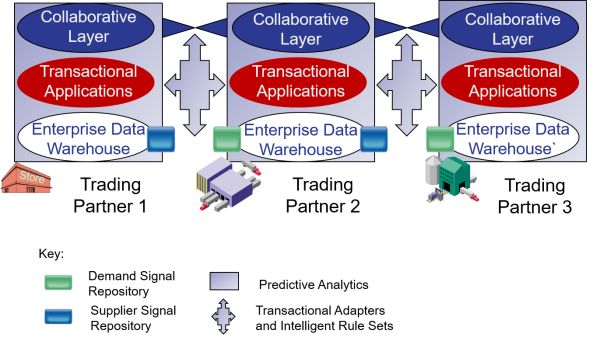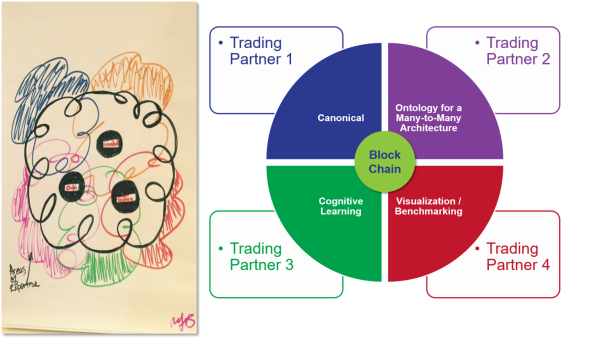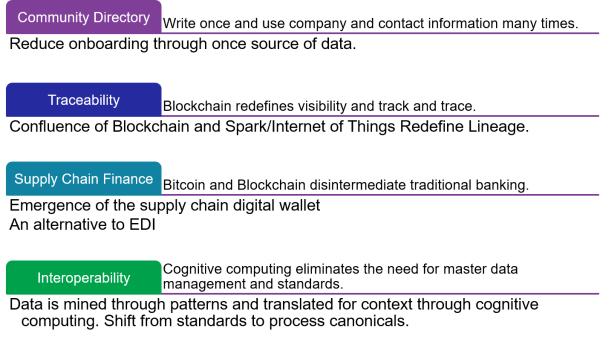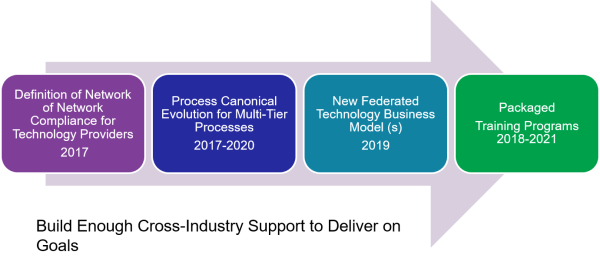 In the 1980s commercial internet providers evolved. In 2001 Steve Jobs put 1000 songs in our pocket. And steadily, over the last three decades, mobile phones changed the pace of business. In the process, the banks got bigger and business networks grew more complex. In the last decade social networks and new business models evolved. eCommerce and electronic shopping carts drove new forms of commerce. It lifted all boats in our personal lives.
In the 1980s commercial internet providers evolved. In 2001 Steve Jobs put 1000 songs in our pocket. And steadily, over the last three decades, mobile phones changed the pace of business. In the process, the banks got bigger and business networks grew more complex. In the last decade social networks and new business models evolved. eCommerce and electronic shopping carts drove new forms of commerce. It lifted all boats in our personal lives.
However, this is not the case for B2B business processes. Data sits–examples include images, map and location data, sentiment, telematics, warranty, and weather– on the doorsteps of manufacturing companies and retailers. These signals cannot be used. There is no place to put them in conventional enterprise technology architectures. As a result, supply chains respond. They do not sense. We believe that supply chain business networks need an overhaul.
Supply chain transactions remain dependent on EDI messaging standards which are now over 45-years old. In the last decade, EDI technology providers consolidated and innovation slowed. Connectivity in our personal lives leap-frogged expectations while B2B networks regressed. Today, companies are drowning in data and low on insights. Data does not move at the speed of business. Instead, data lies in pools within functions of the organization.
Connecting business-to-business trading partners is difficult, too costly and inefficient. There is an opportunity cost. Today’s supply chain is more dependent on supplier and customer relationships. The process is more complex, and more important; but we are not making much progress.
Let’s take an example. Onboarding a supplier today takes two to five months, and while supply chain professionals wax eloquently about multi-tier processes, and driving value in business networks, it is not today’s business reality.
I have studied this space for the last 15 years. I say ENOUGH! Let’s drive change. This is why I started the Network of Networks initiative, i.e. to jumpstart that change.
Reflections
Someone asked me the other day how I adopted the name for this blog. My first goal was to find an available URL and Supply Chain Shaman met this requirement. While I shun the religious and spiritual connotations of the word Shaman, I gravitate to a shaman’s role as a visionary to educate and heal. This is what I am attempting to do in my work at the Network of Networks sessions. To do this we bring together business and technology leaders to ideate together.
Today’s supply chain is sick. Companies struggle to make progress in their continuous-improvement programs. Strapped IT budgets grow burdened by the maintenance costs of historic spend. Processes are not equal to the task. Traditional approaches attempted to optimize a nonlinear system through linear optimization. Mistaken advice from consultants’ focus became functional excellence and project management. As a result, expectations are not being met.
Sharing My Personal Bias
Ask anyone about Lora Cecere and they will probably share that I am a woman of strong opinions. No denying the truth. I will never be known as a milquetoast.
During 1992-2001 I worked for a software vendor, Manugistics, and was part of a think tank tasked to develop a vision for the future of supply chain planning software. Before joining a software company I managed production and distribution facilities for large consumer products companies: Clorox; Dreyer’s Grand Ice Cream, now Nestlé; Kraft/General Foods, now Kraft/Heinz; and P&G. I was very fortunate to have rich experiences–building and starting up new products, implementing software, and driving continuous improvement programs– in established companies across the industry. Entering the world of software was a jolt. Why? It was a different cultural DNA, pace, and business model. Making the transition was difficult, but I feel fortunate to have been able to walk in the safety shoes of the practitioner, draw on the whiteboards at a software vendor, and then move into the research world to share insights with others.
When I joined the Advisory Services Group in Supply Chain at the Gartner Group in 2002, the concept of trading exchanges was exploding. We were tracking hundreds in a turbulent market. Today there are 11 major players: Descartes; GHX; Exostar; IBM (Sterling); INFOR (GT Nexus); Elemica; E2open; OpenText (GXS); One Network; SAP Ariba; and SupplyOn. There is no connectivity between these networks, and onboarding is long and expensive. We are not achieving on the promise. The efficiency and effectiveness of business networks eludes us.
At that time the commonly held view was that business networks would happen on the back of Enterprise Resource Planning (ERP). The worldview was there would be a series of connections from ERP and that the applications of Customer Relationship Management (CRM) and Supplier Relationship Management (SRM) would be the natural adaptors to build the network. I know that you know now how flawed this logic is. In those days, I would sit at my desk and contrast the implosion of the trading network market, driven by visionaries and technology innovators, with the more limited views of the enterprise technology software vendors rapidly being dominated by a few ERP vendors.
 In 2002-2003 I fought a personal battle within internal walls of Gartner Group, fighting a concept called ERP II. I lost the heated debates. Gartner’s public advice was to standardize on ERP and build large instances, common instances. The focus was on IT standardization. In this environment, I felt that the analyst could not be independent. There was just too much pressure to comply with the prevailing view of technology vendors. As a result, I gave up and left Gartner because I could not endorse the ERP II logic. I now know I should have fought it more. The belief in ERP II took supply chain planning systems backwards a decade.
In 2002-2003 I fought a personal battle within internal walls of Gartner Group, fighting a concept called ERP II. I lost the heated debates. Gartner’s public advice was to standardize on ERP and build large instances, common instances. The focus was on IT standardization. In this environment, I felt that the analyst could not be independent. There was just too much pressure to comply with the prevailing view of technology vendors. As a result, I gave up and left Gartner because I could not endorse the ERP II logic. I now know I should have fought it more. The belief in ERP II took supply chain planning systems backwards a decade.
How so? While companies needed a common system for transactions to build global supply chains–this is well-served by ERP– the tight coupling of transactional systems to decision support eroded progress. (I will avoid getting on my soapbox. This could be a blog post all in itself.)
Figure 1. ERP II-Centric View of Business Networks

In 2012 I formed the view of B2B networks shown in Figure 2. I believed that companies would use large data warehouses for storage, build new forms of collaborative applications, and decision support would evolve to drive B2B connectivity. At the time, I knew it was nonlinear with many interconnections, and that the drawing was too simplistic. Despite my efforts, the vision did not take flight. There were many reasons. The most important was that the technologies in 2012 were not equal to this vision.
Figure 2. My Vision in 2012

I now think business networks will look more like Figure 3. I think the storage requires read/write schema, massive parallel processing, the use of structured and unstructured text, the support of ontologies and cognitive learning, open models and the inclusion of real-time data. In contrast, today’s supply chain databases are batch with a focus of storing and using only structured data. Computing memory was a barrier in 2002. It is not now.
Figure 3. Evolution of Network of Networks Thinking

I think making this vision a reality hinges on a confluence of technologies: Hadoop, Spark, Blockchain, Cognitive Learning, Semantic Reasoning, Ontologies, Open Data Models, Multi-tier Process Canonicals, and new forms of Descriptive Analytics. We think that this takes testing.
Figure 4. Confluence of Technologies

To do this I think we need to take supply chain technology thinking to a hard left. It is a sharp departure from conventional wisdom. In this blog post I share what this means.
 I believe the Network of Networks architectures are:
I believe the Network of Networks architectures are:
- Distributed
- Open
- Outside-in Based on Multi-Tier Processes
- Based on Adaptive Learning Engines (Cognitive Learning, Ontologies and Machine Learning)
- Inclusive of Structured and Unstructured Data
- Moving Data at the Speed of Business (Real-time and Batch)

This is a sharp contrast to conventional supply chain investments. The focus of traditional projects is a hard right. What do I mean? Most companies’ IT projects are multi-year projects built on traditional supply chain systems which are:
- Proprietary
- Closed
- Batch
- Linear and Single Tier
- Fixed
- Inside-out
- Dependent on Standards and Hard Coding of Data
Can we take a hard left? I don’t know. We need to prove the value proposition through testing. I think that the new technologies that are equal to the challenge, but we will have bumps and bruises. New business models will evolve built on new technologies. It requires education, and the shift is anything but easy. It will take a village. This is the basis of the Network of Networks effort.
What Is the Network of Networks Effort?
To drive progress I started an initiative termed the Network of Networks in the spring of 2016. It is open to all technology providers and business users. We have had three meetings. Our next meeting is the middle of April. Our goal is to test the concepts in live sandboxes and share the results openly at the September Imagine 2017 conference. We are lucky to have Schneider Electric volunteer to let the group test the storyboards in their digital dirt.
What is the goal of the Network of Networks initiative? “It is the adoption of distributed and open technology by the ecosystem of technology providers and business leaders to drive interoperability in networks to deliver new outcomes.” This is a simple statement for a big idea.
We realize that no one vendor or trading partner can make this happen. It needs to be a community effort and requires the rethinking of network capabilities.
The Potential Value Proposition
There are many angles to take in the testing. The first focus will be on digital onboarding and a community registry. The second pilot will be the combination of Apache Spark with Blockchain and Cognitive Learning to test data mapping of disparate systems requiring data at different speeds. In the future there are many possibilities. Some of the ideas are outlined in Figure 5.
Figure 5. Possibilities of the Network of Networks

We do not know where this will lead. While we hope for a revolution in supply chain technology process thinking, we must stay grounded. Listed in Figure 6 are the group’s aspirational goals.
Figure 6. Group Goals

The pilots and meetings are open. On January 11, 2017 at 10:00 ET, we will host a webinar as a call to action for participants in the pilots. We hope to have you join the effort! It will take early adopters, late followers, and technology compliance by solution providers. The early adopters in the pilots will absorb their costs and provide data while signing a release on NDA and intellectual property development. We look forward to sharing the details with you, and hopefully get your support for our efforts.







